- Acta Photonica Sinica
- Vol. 50, Issue 3, 119 (2021)
Abstract
Keywords
0 Introduction
The application of the terahertz wave has been known as a hotspot in the field of nondestructive testing. Furthermore, this methodology overcomes the limitations of traditional nondestructive testing technologies, penetrates into common nonmetallic materials, and provides non-invasive, non-contact, and non-ionizing methods without any health risk. On the other hand, the terahertz wave methodology can also provide valuable information on the properties of materials. In recent years, terahertz radiation in the domain of 0.1 ~ 3 THz has been used to analyze the internal structure and thickness of the layered materials including multilayer composites, thermal barrier coatings, multilayer polymer structures, etc. These materials are opaque under the irradiation of visible and infrared lights, but permeable towards terahertz waves. This technology has been successfully used to characterize and identify materials with composite structures such as Glass Fiber Reinforced Plastic (GFRP) composites, integrated circuit packaging systems, pharmaceutical tablets, polymer-coated steels, plastic welding and so on[
Ref.[2] revealed that THz-TDS (THz time-domain spectroscopy) can reveal the glass transition temperature of polymers. Ref.[3] has demonstrated the use of THz-TDS system to in situ monitor concentration of the additives in a melting polymer. In Ref.[4], THz-TDS is applied to measure the air stratification thickness in the welded plastic structural parts and enables evaluation of the welding quality. These are some specific application prospects to the THz technology in the inspection of quality of the welded plastic joints. Thus, THz-NDT technology can be applied to the whole industrial chains including characterization of polymers, quality control of the online production, detection of the polymers in the synthetic processes, and demonstrating the potential of THz in the production of polymers.
In the process of THz nondestructive testing of composite polymers, it is necessary to measure the thickness of each layer, refractive index and other material parameters to achieve the internal defects or lamination of a polymer[
On the one hand, the reflection mode of THz wave can be deduced in the three-layer medium transmission model, made from a polyethylene powder and Polyvinyl Chloride(PVC) sheets of the three-layer composite structure of the tablet sample. Then, we can measure the transfer function of the sample by the terahertz time-domain spectroscopic system through a genetic algorithm calculation theory based on the minimum error and measured transfer functions to estimate the thickness and refractive index of the hidden layer of a PVC sheet. Compared to the results of the thickness gauge, we can estimate the results of the error sources and verify the accuracy of this procedure.
1 Theoretical principle
1.1 Theoretical model
When the terahertz pulse was propagated in the multilayer medium, the transmitted and reflected electric fields involved all the dielectric information about the medium. In such a case, the interface between the layers reflected the incident THz pulse and caused attenuation of the transmitted pulse. Different delay propagation pulses and their delay layer reflections can provide the thickness and internal structural states of the material[
Assuming that terahertz is a vertical incident on the sample surface, the analyzing material would be uniform, isotropic, and non-magnetic. The sample transmission model due to the terahertz pulse, directed towards an internal sandwich, as is shown in Fig.1. The sample containing the sandwich can be seen as a medium with a three-layer structure. When the THz pulse was coincided with the specimen, part of the terahertz wave was reflected back from a series of interfaces between layers after attenuation of each layer, and repeated transmissions and reflections between the adjacent interfaces. The other part of the terahertz wave was entered the free space of the sample through the back of the specimen. The real index of the refraction can describe the dispersion of the sample and the corresponding extinction coefficient illustrates the absorption characteristics of the sample, both of which depend on the frequency[
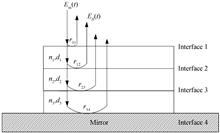
The schematic diagram of the interaction between the terahertz wave and the three-layer medium is shown in Fig.1[
where l= 1, 2, 3, and rij is the Fresnel reflection coefficient, and transmission factor of the medium is expressed as follows .
The terahertz wave passes through the multiple transmissions and reflections in the three-layer structure. Thus, the Rouard equivalent interface theory can be applied to describe the wave propagation in a multi-layer structure. The specific calculation steps are as follows: first, the effective reflection coefficient R3(f) of medium 3 was calculated, as shown in Eq.(3). As the media 2 and 3 were equivalent to one medium, the effective reflection coefficient R3 of the medium 3 can be replaced with r23. The effective reflection coefficient of the equivalent medium 2, Req2, was calculated, as shown in Eq.(4). Then, the equivalent media 2 and 1 are equivalent to medium 1 and Req2 can be used instead of r12[
In the reflection measurement, the total reflection signal obtained from the conductive metal mirror was used as a reference and the ratio of the reflected signal to the reference signal of the sample was introduced as the transfer function, which can be obtained as follows.
1.2 Parameter extraction algorithm
The genetic algorithm, as a kind of the searching optimal solution, can be obtained by simulating the natural evolution process. Fig.2 shows the flowchart of the Genetic Algorithm(GA) that calculetes the concentration of the thickness and refractive index. First, the method of a genetic algorithm works bases on the coding of the initial population, the initial values of thickness and refractive index are set, each individual is composed of two 15-bit binary data strings, which represents the thickness and refractive index of the middle layer. Secondly, all individuals in the population fitness are calculated. Third, through a series of selection, crossover and a mutation genetic, which operators according to the principle of selection and keeps individuals in a high fitness, a new generation of the population is obtained. Therefore, the genetic search direction in a part of the solution space can be more adapted to disclose the optimal solutions. Finally, the best result of the thickness and refractive index are obtained by decoding. A genetic algorithm relies on the selection of optimization function of the initial value and function of convergence. However, repeated operations may provide different results. Thus, in order to guarantee the stability of the results, on the one hand, strict restriction conditions are given, and on the other hand, the fitness value of the best chromosome is compared through multiple runs, and the minimum fitness value is selected to obtain the optimal solution[
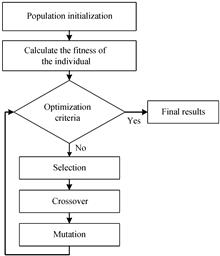
The fitness function in the above method is obtained by calculating the Mean Squared Error (MSE) of the measured transfer function and the modeled function obtained by the model. As shown in Fig. 3, the incident wave Ein(t)was directly coincided with the sample surface in an actual measurement. Whereas, the reflected wave ER(t) contained information (di, ni)on the medium in the middle layer, etc. When only the conductive mirror is available, the reference reflected wave Eref(f) can be obtained. The deconvolution of the frequency of the measured time signal can be shown as
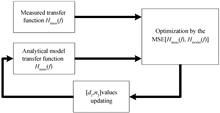
Emeas(f)is the Fourier transform of the time domain signal ER(t), and Eref(f) is the Fourier transform of the reference reflected wave Eref(t), in the frequency domain. Therefore, Fig. 3 is a simplified parameter estimation flow chart. Since this model contains unknown quantities such as material parameters, we compared the measured signals with that of the model. By comparing the mean square error and using the genetic algorithm, the unknown parameter set was constantly updated and, therefore, the optimal parameter combination solution was solved.
2 Experimental setup and samples
2.1 Experimental setup
THz-TDS is a new physical method for measuring and analysis, which has been developed rapidly in recent years. THz-TDS is a powerful tool to detect and analyze the physical properties of materials. It adopts the coherent detection technology to obtain the spectral signal of the terahertz transmitted or reflected from samples and is generally based on an electric-field time-domain waveform. After transformation of the frequency domain, the spectral information related to the essence of samples such as refractive index and absorption coefficient can be directly obtained[
The THz time-domain spectral system used in this study is produced by the Zomega company in the United States. The bandwidth range of the system is 0.1 ~ 4 THz, the dynamic range is greater than 58 dB, and the measurement delay time is up to 100 ps. The system can provide transmission and reflection modes and the output power is 20 ~ 30 mW,include fiber optic femtosecond lasers, emitters and detectors. The laser pulse interacts with the optical conducting antenna to produce a THz pulse with a terahertz pulse width of 250 fs, a time-domain range of 0 to 100 ps, a resolution of 0.05 ps, and a spot diameter of 1 mm for the terahertz wave. The structure of this system is shown in Fig. 4[
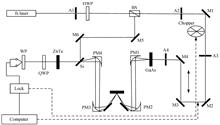
2.2 Sample preparation
In order to verify the accuracy of the multi-layer model parameter extraction method, polyethylene (PE) powder and PVC thin sheets were pressed to obtain a sample of the three-layer including pe-pvc-pe, as shown in Fig. 5. Both materials are dispersion-free. The polyethylene powder and PVC film used in this experiment showed low absorption characteristics to the terahertz waves and, thus, a low refractive index was attained because the terahertz wave can pass through these two materials[

A specific route for the preparation of the PE powder embedded with a PVC sheet (0.2 mm×0.2 mm thickness) after hydraulic pressure, firstly involves a PVC sheet with a 0.2 mm specification, cutting for 1 mm×1 mm square with the weight of 0.150 g. Then, poured into a diameter of 2 mm mould and induced by a powder pressing pressure to attain the cut out good PVC sheet (called 0.15 g PE powder). Again a 10 MPa hydraulic pressure was induced to the PVC sheet to get the tablets.
A PVC sheet (0.2 mm) was embedded in the middle of PE powder, which was put into a mold and pressed into a tablet with a diameter of 2 mm by a hydraulic press. Hold the tablet at the pressure of 10 MPa for 30 s, then relaxed for one min. 0.3 g weight and 0.2 g weight of PE powders were prepared, respectively. The tablets without PVC sheet were used to compare and extract the absorption coefficient and refractive index of the PE powder. The size of each sample was 2 mm in diameter and the thickness was about 1.8 mm.
3 Results and discussions
To validate the method proposed in the paper, we designed eight samples with three layers. Each sample was measured by THz-TDS to obtain the reflection spectrum and reference spectrum, as shown in Fig. 6. In the experiment, the reflective THz-TDS technique was used to obtain the test data, and the angle of incidence is normal. Firstly, the time domain waveform of THz, passing through the air was extracted as the reference signal. Then, the time domain waveform of the THz wave passing through the sample was extracted as the sample signal waveform. Secondly, Fourier transform was carried out on the reference and sample signal waveforms, respectively, and the transfer function of the measured sample was obtained through deconvolution. The measured transfer function was compared with the theoretical model derived in 3.1 and the GA (genetic algorithm) was used to solve the two unknown parameters, including the hidden layer thickness and refractive index in the theoretical model. In order to reduce the random error, three groups of samples were prepared in this experiment. Table 1 shows the true thicknesses measured by the thickness gauge, the true value of refractive index, the estimated hidden layer thickness, and the comparative refractive indices.
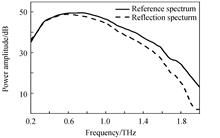
| No. | Method | Thickness/mm | Error/% | Refravtive index | Error/% |
|---|---|---|---|---|---|
| 1 | Mesured value | 0.200 | 1 | 0.8 | |
| Estimated value | 0.202 | ||||
| 2 | Mesured value | 0.200 | 2.5 | 12.8 | |
| Estimated value | 0.205 | ||||
| 3 | Mesured value | 0.200 | 4 | 12.8 | |
| Estimated value | 0.208 | ||||
| 4 | Mesured value | 0.200 | 0.15 | 1.5 | |
| Estimated value | 0.203 | ||||
| 5 | Mesured value | 0.200 | 1 | 12.7 | |
| Estimated value | 0.202 | ||||
| 6 | Mesured value | 0.200 | 1 | 0.9 | |
| Estimated value | 0.198 | ||||
| 7 | Mesured value | 0.200 | 2 | 0.6 | |
| Estimated value | 0.204 | ||||
| 8 | Mesured value | 0.200 | 0.5 | 0.5 | |
| Estimated value | 0.201 |
Table 1. The sample thickness, refractive index and quantitative error were obtained by genetic algorithm
As for the thickness estimation error, it can be seen that the thickness estimation error was less than 4%. In addition, the reason for the error was due to the hidden layer, which can not be placed completely horizontally in the sample pressing process. Therefore, a certain tilt may exist, leading to deviation of the measurements. On the other hand, the crossover and mutation probability in GA may have a certain influence on the obtained results.
As for the refractive index error, it can be seen from Table 1 that the errors of No. 2 and 3 samples are as high as 12.8%. On the other hand, the error of the estimated refractive index of other samples is relatively small. On the one hand, the selection of the initial value of genetic algorithm, the number of iterations and other factors will have a great impact on the estimated result; on the other hand, the measurement result of the system will be affected by the system noise, sample uniformity and so on, leading to a large deviation of the measured value. In the end, if the refractive index of the medium is calculated from the complex dielectric constant model, the refractive index estimation will be more accurate.
4 Conclusion
The THz-TDS system is firstly introduced in the reflection mode by consideration of the low absorptivity of the terahertz in the polyethylene powder and polyvinyl choride (PVC). Another research objective is focused on the specific production of polyethylene powder inside the tablet containing PVC, which leads to a three-layered sample with a composite structure. THz-TDS system can measure the samples through the deconvolution process and gets the transfer function data. Then, the transmission model of the terahertz waves in the three-layer medium in the reflection mode is derived according to the transmission characteristics of the terahertz waves through multiple transmissions and reflections in the three-layer structure by using the Rouard equivalent interface theory to describe the propagation of waves in a multi-layer structure. The unknown quantities in the model include the thickness and refractive index of the middle layer, which can be ascribed in this method. Finally, through calculation of the GA theory of minimum error and measured transfer functions, we can estimate the thickness of the hidden layer of PVC sheet along with the refractive index to guarantee the stability of the results. In addition, this investigation puts forward strict restrictions, through many times running and by every time comparison of the best fitness value of chromosome with fitness value of the minimum to get the optimal solution. Compared to the results of thickness gauge, the error sources of the estimated results are analyzed and the accuracy of this method is verified.
References
[1] Junliang DONG, A LOCQUET, DS CITRIN. terahertz quantitative nondestructive evaluation of failure modes inpolymer-coated steel. IEEE Journal of Selected Topics in Quantum Electronics, 23, 1-7(2017).
[2] S WIETZKE, C JANSEN, T JUNG. Terahertz time-domain spectroscopy as a tool to monitor the glass transition in polymers. Optics Express, 17, 19006-19014(2009).
[3] N PALKA, A RYBAK, T JAKUBOWSKI. Monitoring of air voids at plastic-metal interfaces by terahertz radiation. Infrared Physics & Technology, 104, 9(2020).
[4] K MURATE, K KAWASE. Perspective: terahertz wave parametric generator and its applications. Journal of Applied Physics, 124, 10(2018).
[5] S K KIM, J A JUNG. NDE characterization and inspection techniques of trailing edges in wind turbine blades using terahertz waves. Journal of Mechanical Science and Technology, 33, 4745-4753(2019).
[6] P LOPATO. Automatic defect recognition for pulsed terahertz inspection of basalt fiber reinforced composites. Compel - The international Journal for Computation and Mathematics in Electrical and Electronic Engineering, 35, 1346-1359(2016).
[7] S K KIM, J A JUNG. Terahertz scanning techniques for paint thickness on CFRP composite solid laminates. Journal of Mechanical Science and Technology, 30, 4413-4416(2016).
[8] Binghua CAO, Mengyun WANG, Xiaohan LI. Noncontact thickness measurement of multilayer coatings on metallic substrate using pulsed terahertz technology. IEEE Sensors Journal, 20, 3162-3171(2020).
[9] S KRIMI, J KLIER, J JONUSCHEIT. Highly accurate thickness measurement of multi-layered automotive paints using terahertz technology. Applied Physics Letters, 109, 021105(2016).
[10] Junliang DONG, P POMARÈDE, L CHEHAMI. Visualization of subsurface damage in woven carbon fiber-reinforced composites using polarization-sensitive terahertz imaging. NDT and E International, 72-79(2018).
[11] S KRIMI, G TOROSYAN, R BEIGANG. Advanced GPU-based terahertz approach for in-line multilayer thickness measurements. IEEE Journal of Selected Topics in Quantum Electronics, 23, 1-12(2017).
[12] G P KNIFFIN, S SCHECKLMAN, J CHEN. Measurement and modeling of terahertz spectral signatures from layered material, 7687, 1-11(2010).
[13] Jie WANG, Jin ZHANG, Tianying CHANG. Terahertz nondestructive imaging for foreign object detection in glass fibre-reinforced polymer composite panels. Infrared Physics & Technology, 98, 36-44(2019).
[14] Zhi LI. Genetic algorithm that considers scattering for THz quantitative analysis. IEEE Transactions on Terahertz Science and Technology, 5, 1062-1067(2015).
[15] G P KNIFFIN, L M ZURK. Model-based material parameter estimation for terahertz reflection spectroscopy. IEEE Transactions on Terahertz Science and Technology, 2, 231-241(2012).
[16] S H PARK, D H KIM. Nondestructive evaluation of hidden multi-delamination in a glass-fiber-reinforced plastic composite using terahertz spectroscopy. Composite Structures, 156, 338-347(2016).
[17] Jin ZHANG, Jie WANG, Xiaohui HAN. Noncontact detection of teflon inclusions in glass-fiber-reinforced polymer composites using terahertz imaging. Applied Optics, 55, 10215-10222(2016).
[18] A ABINA, A JEGLIČ. Structural characterization of thermal building insulation materials using terahertz spectroscopy and terahertz pulsed imaging. NDT & E International, 77, 11-18(2016).
[19] Shuncong ZHONG. Progress in terahertz nondestructive testing: A review. Frontiers of Mechanical Engineering, 14, 273-281(2018).
[20] I CATAPANO, F SOLDOVIERI, L MAZZOLA. THz imaging as a method to detect defects of aeronautical coatings. Terahertz Waves, 38, 1264-1277(2017).

Set citation alerts for the article
Please enter your email address



